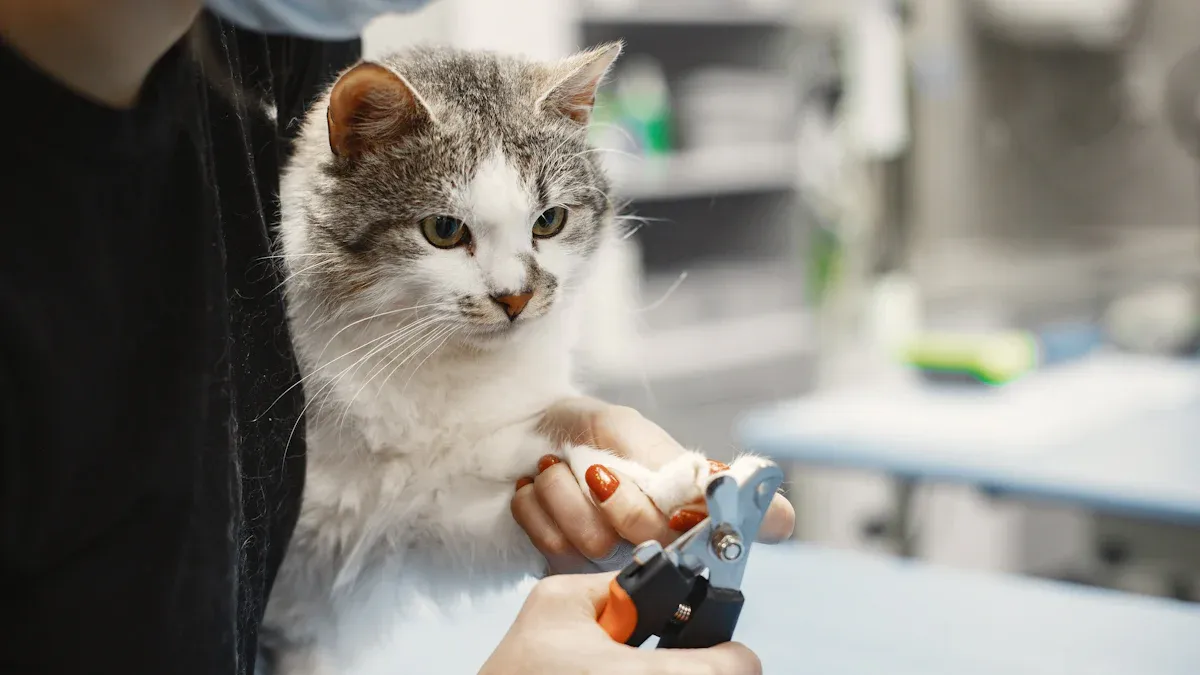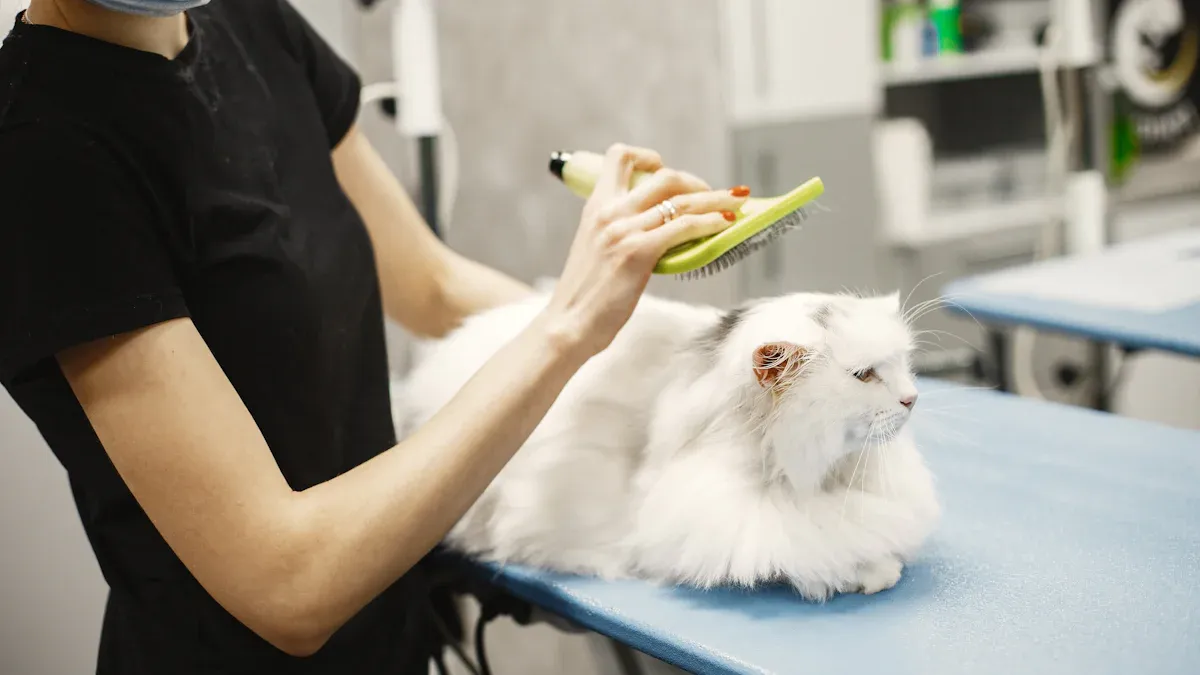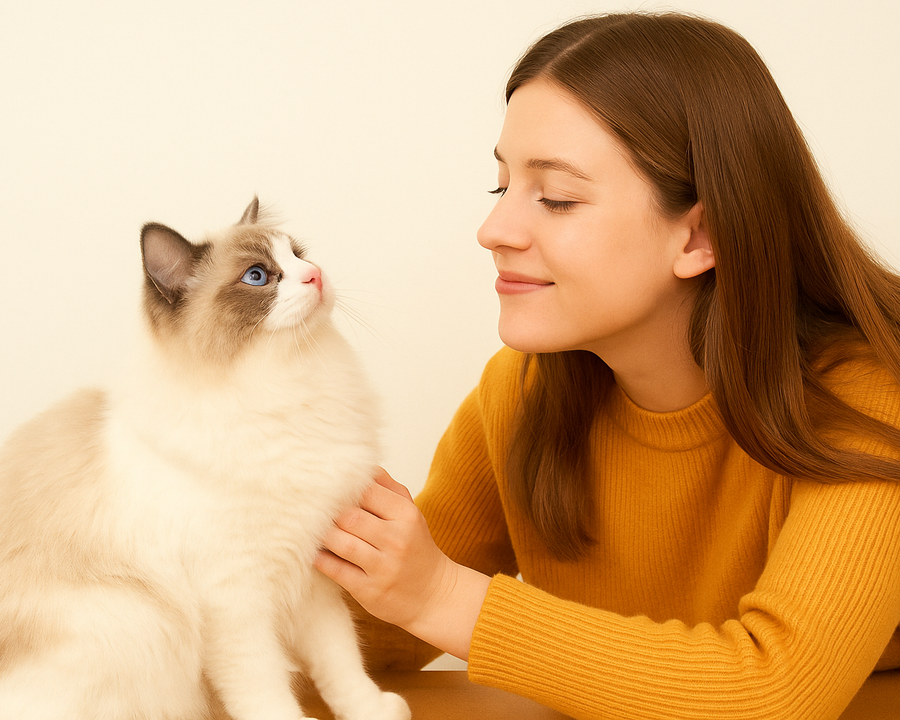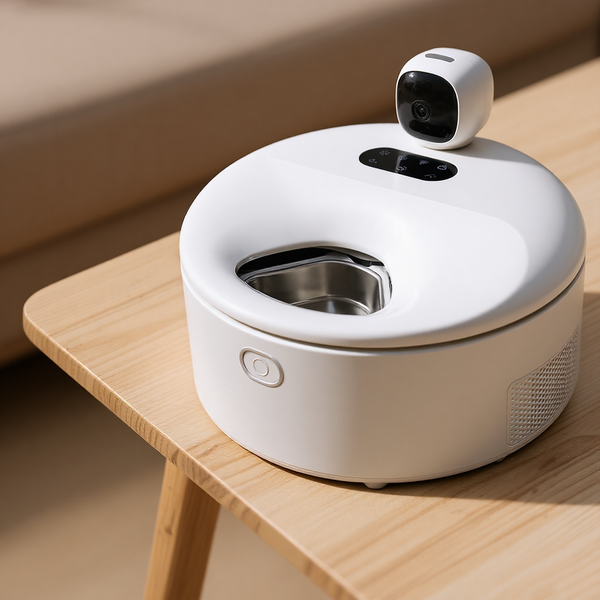
You want your cat to look and feel its best every day. The top 10 cat grooming supplies—brushes, combs, nail clippers, grooming gloves, cat shampoo, conditioner, grooming wipes, ear cleaner, dental care tools, and grooming scissors—keep fur smooth, nails trimmed, and skin healthy. Regular grooming helps you notice changes in your cat’s coat, spot cuts or bumps early, and even strengthen your bond. With the right tools, you can prevent matting, control shedding, and keep your cat comfortable at home.
Key Takeaways
-
Regular grooming keeps your cat's coat healthy and helps you spot health issues early.
-
Use the right grooming tools for your cat's fur type to prevent mats and control shedding.
-
Grooming strengthens your bond with your cat, making them feel safe and loved.
Why Grooming Matters
Health Benefits
Grooming does more than keep your cat looking cute. It helps you spot health problems early and keeps your cat’s skin and fur in top shape. When you use cat grooming supplies often, you help your cat avoid many common issues.
-
Regular brushing stops mats from forming and cuts down on shedding.
-
Brushing removes loose fur, so it does not tangle or cause hairballs.
-
Short-haired cats need weekly brushing, but long-haired cats need it every day.
-
Grooming lets you find fleas or ticks before they become a big problem.
Tip: A healthy diet also helps your cat’s coat stay soft and easy to manage.
Comfort and Bonding
Grooming is not just about health. It is also a great way to make your cat feel safe and loved. When you brush or clean your cat, you build trust and make your bond stronger.
-
Spending time together during grooming makes your cat want to be close to you.
-
Cats who enjoy grooming with you often seek out more cuddles and attention.
You can turn grooming into a special time for both of you. With the right cat grooming supplies, you make every session easy and enjoyable.
Essential Cat Grooming Supplies
Keeping your cat clean and comfortable starts with the right tools. Let’s break down the top cat grooming supplies you need and why each one matters.
Brushes and Combs
You can’t skip brushes and combs if you want your cat’s coat to stay smooth and healthy. The right brush depends on your cat’s fur type. Here’s a quick guide:
|
Brush Type |
Suitable For |
Description |
|---|---|---|
|
Pin Brushes |
All coat types |
Gentle for daily use, tackles minor tangles with rubber tips for comfort. |
|
Bristle Brushes |
Short and long-haired cats |
Removes loose hair and smooths the coat, preventing mats and tangles. |
|
Slicker Brushes |
Short-haired cats |
Effective for light brushing, removes loose fur and small tangles. |
|
Skip Tooth Combs |
Long-haired cats |
Penetrates the undercoat, ideal for small mats and grooming. |
|
Deshedding Tools |
All coat types |
Curved tines grip and remove excess fur, recommended for monthly use. |
|
Dematting Rakes |
All coat types |
Best for stubborn mats, curved tines for better grip. |
|
Grooming Gloves |
Sensitive cats |
Gentle, helps cats get used to grooming, less likely to overstimulate. |
|
Curry Brushes |
All coat types |
Removes loose hair, massages, and helps during bathing. |
If your cat has short hair, use a slicker or pin brush for small tangles and loose hair. For long-haired cats, a deshedding rake and skip tooth comb help manage mats. In homes with more than one cat, a combo pin and bristle brush works for everyone.
Tip: Regular brushing keeps shedding under control and helps you spot skin problems early.
Nail Clippers
Trimming your cat’s nails keeps them from getting too long or sharp. You have a few choices, like scissor-style or guillotine clippers. Look for these safety features:
|
Feature |
Description |
|---|---|
|
Sharp Blades |
Clean cuts without pulling or splitting the nail. |
|
Safety Locks |
Prevents accidental opening when not in use. |
|
Comfortable Grips |
Makes it easier to hold steady, so you don’t slip. |
|
Safety Guard |
Stops you from cutting too short, which can hurt your cat. |
Scissor-style nail clippers are great for beginners. Guillotine clippers are quick and easy for small paws. Always trim just the tip to avoid hurting your cat.
Grooming Gloves
Some cats don’t like brushes. Grooming gloves let you pet your cat while you remove loose fur. They work well for sensitive cats and help them get used to grooming. Gloves are gentle and less likely to cause stress. Many cats even purr or rub against you when you use them.
Note: Grooming gloves are a great way to bond with your cat and keep fur off your furniture.
Cat Shampoo
Cats don’t need baths often, but sometimes you have to clean up messes or help with allergies. Choose a shampoo made for cats. Avoid these ingredients:
-
Sulfates: Can dry out and irritate your cat’s skin.
-
Parabens: Linked to health problems.
-
Formaldehyde releasers: Harmful to both pets and people.
-
Artificial fragrances: Too strong for sensitive cats.
Waterless cat shampoo is a good choice if your cat hates water. It’s easy to apply and doesn’t need rinsing.
Conditioner
If your cat has long or thick fur, conditioner can help. It makes brushing easier by detangling knots and preventing mats. Conditioner also adds a barrier to protect fur from damage. Use it sparingly, since too much can upset the natural oils in your cat’s coat.
Grooming Wipes
Grooming wipes are perfect for quick cleanups. They work well for cats who hate baths or have sensitive skin. Look for wipes that are:
|
Feature |
Description |
|---|---|
|
Hypoallergenic |
Reduces allergic reactions, safe for sensitive skin. |
|
Gentle Cleaning |
Cleans without causing irritation. |
|
Eco-friendly Materials |
Made from plant-based, biodegradable fibers. |
|
Free from Harmful Chemicals |
No alcohol, parabens, sulfates, or dyes. |
You can use wipes to clean paws, fur, and even around the face.
Ear Cleaner
Cats need clean ears to avoid infections. Pick an ear cleaner with safe ingredients like distilled water, apple cider vinegar, or a little aloe vera gel for soothing. Avoid harsh chemicals. Gently wipe the outer ear—never push anything deep inside.
Dental Care Tools
Dental care is often overlooked, but it’s just as important as brushing fur. Use a cat toothbrush and toothpaste made for pets. These tools help remove plaque and tartar, which can cause gum disease. Start brushing your cat’s teeth when they’re young, and try to make it a daily habit.
-
Cat toothbrushes have soft bristles for small mouths.
-
Cat toothpaste is safe to swallow and comes in flavors cats like.
Eye Wipes
Some cats get tear stains or debris around their eyes. Eye wipes make it easy to keep this area clean. Here’s how to use them:
-
Gently wipe away debris from around one eye with a presoaked pad.
-
Use a new pad for the other eye.
-
Repeat daily until stains disappear, usually within a week.
-
For maintenance, use weekly to prevent stains from coming back.
Flea Comb
A flea comb helps you find and remove fleas before they become a big problem. It works best for checking your cat’s fur and catching fleas early. Flea combs are most effective for mild infestations or as part of a regular checkup. For severe cases, you may need other treatments.
Grooming Scissors
Grooming scissors help you trim mats or long fur around sensitive spots. Always use scissors made for pets. Be careful—cats have thin skin, and accidental cuts can happen. Watch for any signs of injury after grooming.
Safety tip: If you accidentally nick your cat, clean the area and use a little antibiotic ointment.
You can find many of these cat grooming supplies at Petcantalk, where quality and your pet’s comfort come first. While you’re building your grooming kit, consider the Polar Smart Wet Food Feeder as a bonus for overall pet care. It makes mealtime easy and enjoyable for both you and your cat.
How to Use Cat Grooming Supplies

Tips for Brushing
Start slow when you introduce brushing to your cat. Let your cat sniff the brush first. Pick a time when your cat feels calm. Use gentle strokes in the direction of the fur. Choose a brush that matches your cat’s coat. Bristle brushes work well for short hair, while slicker brushes help with long hair. Clean and sharp tools make brushing more comfortable. Give treats and praise to help your cat enjoy grooming. If your cat gets nervous, take a break and try again later.
Safe Nail Trimming
Nail trimming can feel tricky, but you can do it safely. Gently press your cat’s paw pad to extend the nails. Always trim just the tip, staying away from the pink quick. Start with the back paws, then move to the front. Use clippers made for cats, not human ones. Keep styptic powder nearby in case you trim too short. Don’t forget the dewclaw on the inside of the paw. Trim nails regularly to keep your cat comfortable.
Bathing and Wiping
Most cats don’t need frequent baths, but sometimes it’s necessary. Use warm water and a cat-friendly shampoo. Make sure your cat feels safe and secure. For quick cleanups, use grooming wipes. Here’s a handy guide for how often to bathe or wipe your cat:
|
Coat Type |
Recommended Frequency |
|---|---|
|
Short-Haired Cats |
Every few months |
|
Long-Haired Cats |
Every 4 to 6 weeks |
|
Hairless Cats |
Every week or two |
|
Indoor Cats |
Every 3 to 6 months |
|
Outdoor Cats |
Every month or two, depending on dirtiness |
Cleaning Ears and Eyes
Use a vet-approved ear cleaner. Gently wipe the outer ear with a soft cloth or cotton ball. Never push anything deep into the ear. Watch for redness or scratching. For eyes, use a clean pad for each eye and wipe away debris. If you notice any swelling or discharge, talk to your vet.
Dental Care Routine
Brush your cat’s teeth daily or at least a few times a week. Use a toothbrush and toothpaste made for cats. Dental treats and water additives can help reduce plaque. Schedule a dental checkup every year. Regular brushing keeps your cat’s mouth healthy and fresh.
Introducing Grooming to Cats
Building Positive Habits
You want your cat to feel safe and happy during grooming. The best way to do this is to start early and make grooming a regular part of your cat’s life. If you have a kitten, begin brushing and handling them as soon as possible. For adult cats, you can still build good habits with patience.
-
Offer treats or a favorite snack after each grooming session. This helps your cat link grooming with something positive.
-
Use gentle strokes and talk softly to your cat. Calm words and a gentle touch make your cat feel secure.
-
Keep sessions short at first. Just a few minutes is enough. As your cat gets used to grooming, you can slowly make each session longer.
-
Stick to a routine. Groom your cat at the same time and place so they know what to expect.
-
Praise your cat with kind words or a gentle pet when they stay calm.
Tip: Positive reinforcement, like treats and praise, turns grooming into a fun and rewarding experience for your cat.
Handling Resistant Cats
Some cats do not enjoy grooming right away. You can help them feel better with a few simple techniques.
|
Technique |
Description |
|---|---|
|
Watch your cat’s body language to see why they resist. |
|
|
Creating a calm environment |
Play soft music or use calming sprays to help your cat relax. |
|
Proper restraint techniques |
Wrap your cat in a towel (like a "kitty burrito") to keep them safe and still. |
|
Gradual introduction to tools |
Let your cat sniff and explore brushes or combs before using them. |
|
Gentle handling and positive reinforcement |
Move slowly and give treats to reward calm behavior. |
|
Taking breaks |
Stop if your cat gets upset. Try again later. |
|
Specialized grooming techniques |
Use special tools or methods for sensitive cats. |
|
Seeking veterinary assistance |
Ask your vet for help if your cat gets too stressed or aggressive. |
You can also give your cat a safe spot to retreat if they feel overwhelmed. Always go slow and use gentle hands. Over time, your cat will learn that grooming is nothing to fear.
Common Mistakes
Over-grooming
You might think more grooming means a healthier cat, but too much can actually cause problems. Over-grooming leads to skin sores and fur loss. Sometimes, cats start grooming too much because they feel stressed or have medical issues. If you notice bald spots or red skin, your cat may be over-grooming. Environmental factors like pests or loud noises can also make your cat anxious and increase grooming. Watch for signs like constant licking or biting at the same spot. If you see these behaviors, talk to your vet. You want to keep your cat clean, but you also want to protect their skin and fur.
Tip: Regular grooming is good, but always pay attention to your cat’s mood and skin condition.
Here are some common grooming mistakes you might run into:
-
Skipping grooming sessions can cause matted fur and dirty paws.
-
Bathing your cat too often strips away natural oils, making skin dry.
-
Forgetting to brush before a bath leads to tangles and trapped hair.
-
Rushing nail trims can hurt your cat and cause bleeding.
-
Using dull clippers increases the risk of razor burn.
-
Getting water in your cat’s ears can cause painful infections.
-
Letting your cat outside while wet means they’ll roll in dirt and undo your hard work.
Wrong Products
Choosing the right grooming products matters for your cat’s health. Some items made for dogs can be toxic or even fatal to cats. Flea control products and shampoos for dogs should never touch your cat’s skin. Ingredients like ammonia can cause breathing problems and skin irritation. If your cat licks ammonia, it can burn their mouth and cause poisoning. Essential oils—like peppermint, citrus, clove, eucalyptus, and tea tree—can damage your cat’s liver and nervous system.
-
Products meant for dogs
-
Ammonia
-
Essential oils (peppermint, citrus, clove, eucalyptus, tea tree)
Always check the label before using any product. If you’re unsure, ask your vet for advice. Your cat’s safety comes first!
You want your cat to feel happy and healthy every day. With the right cat grooming supplies, you make grooming easy and fun.
-
Regular brushing prevents coat problems and helps you spot health issues early.
-
Grooming strengthens your bond and keeps your cat looking great.
Start building your kit and enjoy every moment together!
FAQ
How often should you groom your cat?
You should brush most cats once or twice a week. Long-haired cats need daily brushing. Regular grooming keeps fur clean and helps you spot problems early.
Can you use human shampoo on your cat?
No, never use human shampoo. Cat skin is sensitive. Always pick a shampoo made just for cats. This keeps your cat safe and comfortable.
What if your cat hates nail trims?
Try trimming one nail at a time. Give treats after each trim. Use quiet clippers. If you feel nervous, ask your vet or groomer for help.




